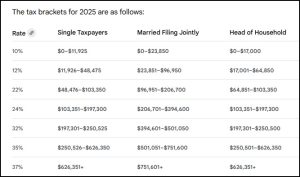Posted on Friday, 10th October 2025 by Dennis Damp
 Print This Post
Print This Post
Last year, I posted an article titled “Too Much Too Soon & Cable TV Subscription Costs,” in which I discussed automation and the high cost of cable TV subscription services.
Ramifications of the Federal Shutdown – The Reality
The house we visited a year ago finally sold last month, at 25% below its original asking price. This home was a custom-built ranch home in our neighborhood, and everything was monitored and remotely controlled. Mary and I couldn’t imagine living with all of the automation, even though it was gorgeous inside and mostly one-floor living.
Even though this home took a year to sell, mainly because it was overpriced to begin with, other new homes in our area continue their upward march.
One of the new ranch home communities was selling 1,400-square-foot ranch homes for the low $300,000s last year and is now offering them for just over $400,000. This is in just a year!
Inflation and Jobs Growth
In August 2025, U.S. job growth was below expectations, with only 22,000 nonfarm jobs added, and the unemployment rate rose to 4.3%. Inflation saw a slight increase, with the annual Consumer Price Index (CPI) reaching 2.9%, up from 2.7% in July. This combination of a slowing job market and rising inflation creates a challenging economic environment for the Fed Chair and other policymakers.
USA Today reported on September 9th, “The Federal Reserve is widely expected to announce a rate cut after its two-day September meeting.” The central bank announced a .25% rate cut on September 17th, and several disappointing job market reports spurred the Fed into action. Some are projecting a total of three rate cuts this year; time will tell.
The health care sector added jobs, but losses occurred in other areas, including the federal government, mining, and manufacturing, which shed 12,000 jobs.
The Bureau of Labor Statistics (BLS) reported 911,000 fewer jobs than previously reported between April 2024 and March 2025, according to preliminary benchmark revisions on September 9, 2025.
This revision indicates that the average monthly job gain was significantly lower, decreasing from 147,000 to 71,000 over those 12 months.
Don’t Cut and Run Without an Annuity – Deferred and Early Retirements
Cable Subscription Costs
Our monthly cable bill climbed to $347 a month recently. I’ve tried numerous times to renegotiate a lower price with Xfinity Comcast and experimented with several streaming plans. Our cable bill is considerably higher than most of our monthly bills.
I finally made headway this month and was able to lower our cable bill by almost 30% to $251 monthly. This included a 5-year price lock on the modem and Wi Fy. When I called them about the escalating costs, they offered several options if I transferred my two cellular lines to them.
The cable companies are seeing many subscribers abandon their services for lower-cost streaming options.
My Verizon cellular monthly cost was $117 for two lines, and Comcast offered a promotional rate of $20 per month for the two phones for a year, after which the cost would increase to $60. They also included two Apple Watches as a bonus; however, there would be a $10 cellular fee per watch, adding $20 a month to my cell phone bill, still less than half my Verizon costs.
We did drop some channels that we never watched anyway, and we haven’t noticed any significant changes in our service, a good deal overall. I experimented with YouTube TV and other streamers and would have moved to one of them had Xfinity not reduced our costs.
The advantage of staying with a cable company is convenience and the availability of service centers in most areas. Plus, their cable remotes are much easier to use, including voice commands. Streaming services are slow to respond to your commands, and you have to use multiple remotes to get to where you want to go. My wife wasn’t interested in having to navigate various remotes for each TV.
Cable Channel Confusion
We were only using a handful of the 200+ channels we had, and seldom watch NBC, CBS, and ABC, except for local news. Most of the time, we use Amazon Prime, Netflix, HULU, and other streaming services, and watch cable news channels, Discovery, HGTV, History, Lifetime, and a few others.
Alternate Route
There are ways to cut the cord using either paid/or free TV streaming services. To get around the prospect of losing your email address, retain your current Internet provider’s internet services. Internet service averages about $80 per month, plus a Wi-Fi modem costs another $15. For information on alternate routes, review the article I wrote last year on the subject.
Summary
The rate cuts will impact retiree savings the most, through lower returns on fixed income investments. Bond, money market yields, and savings account interest will follow suit. There are options to lock up your fixed income for a longer term now before rates drop further.
Please talk with your financial advisor, they often offer higher earning with fixed deferred annuities, bonds, and CD ladders that can lock in rates for anywhere from a few years to 10 or more.
Lowering rates often causes stock share prices to rise, and those fixed-income losses could be recovered in your IRAs and TSP accounts. However, the market typically anticipates movements like this six months before they occur, and this expectation may already be reflected in the stock market. There are many variables to consider, and the stock market is highly volatile, up one day and down another.
The cost of everything is rising faster than most realize, and retirees are often the first to feel the pinch. Explore ways to economize and protect the savings you spent a lifetime accumulating.
Helpful Retirement Planning Tools

 Disclaimer: The information provided may not cover all aspects of unique or special circumstances. Federal regulations, medical procedures, investment information, and benefit details are subject to change. To ensure the accuracy of this information, contact relevant parties for assistance, including OPM’s retirement center. Over time, various dynamic economic factors relied upon as a basis for this article may change.
Disclaimer: The information provided may not cover all aspects of unique or special circumstances. Federal regulations, medical procedures, investment information, and benefit details are subject to change. To ensure the accuracy of this information, contact relevant parties for assistance, including OPM’s retirement center. Over time, various dynamic economic factors relied upon as a basis for this article may change.
The information contained herein may not be suitable for your situation. This service is not affiliated with OPM or any federal entity. You should consult a financial, medical, or human resource professional where appropriate. Neither the publisher nor the author shall be liable for any loss or other commercial damages, including but not limited to special, incidental, consequential, or other damages.
Tags: Fed Rate Cut, Inflation, Jobs Growth
Posted in ANNUITIES / ELIGIBILITY, BENEFITS / INSURANCE, EMPLOYMENT OPTIONS, ESTATE PLANNING, FINANCE / TIP, RETIREMENT CONCERNS, SURVIVOR INFORMATION
Comments (0)|  Print This Post
Print This Post
 Print This Post
Print This Post

 Print This Post
Print This Post



